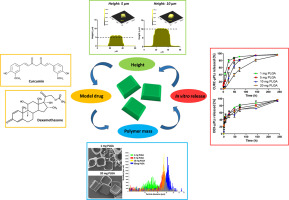当前位置:
X-MOL 学术
›
J. Control. Release
›
论文详情
Our official English website, www.x-mol.net, welcomes your
feedback! (Note: you will need to create a separate account there.)
Engineering shape-defined PLGA microPlates for the sustained release of anti-inflammatory molecules.
Journal of Controlled Release ( IF 10.5 ) Pub Date : 2019-12-30 , DOI: 10.1016/j.jconrel.2019.12.039 Martina Di Francesco 1 , Rosita Primavera 2 , Maria Summa 3 , Martina Pannuzzo 1 , Valentina Di Francesco 4 , Daniele Di Mascolo 1 , Rosalia Bertorelli 3 , Paolo Decuzzi 1
Journal of Controlled Release ( IF 10.5 ) Pub Date : 2019-12-30 , DOI: 10.1016/j.jconrel.2019.12.039 Martina Di Francesco 1 , Rosita Primavera 2 , Maria Summa 3 , Martina Pannuzzo 1 , Valentina Di Francesco 4 , Daniele Di Mascolo 1 , Rosalia Bertorelli 3 , Paolo Decuzzi 1
Affiliation

|
Over the years, nanoparticles, microparticles, implants of poly(D,l-lactide-co-glycolide) (PLGA) have been demonstrated for diverse biomedical applications. Yet, initial burst release and optimal modulation of the release profiles limit their clinical use. Here, shape-defined PLGA microPlates (μPLs) were realized for the sustained release of two anti-inflammatory molecules, the natural polyphenol curcumin (CURC) and the corticosteroid dexamethasone (DEX). Under the electron microscope, μPLs appeared as square prisms with an edge length of 20 μm. The top-down fabrication process allowed the authors to vary, readily and systematically, the μPL height from 5 to 10 μm and the PLGA mass from 1 to 5, 10 and 20 mg. 'Taller' particles realized with higher PLGA concentrations encapsulated more drug reaching on average values of about 150 pg/μPL, for both CURC and DEX. The μPL height and PLGA concentration had major effects on drug release, too. Under sink conditions, DEX release from tall μPLs at 1 h reduced from 50% to 10% and 2% for the 5, 10 and 20 mg PLGA configurations, respectively. Also, DEX was released more slowly from taller as compared to short μPLs. The opposite trend was observed for CURC, possibly for its lower hydrophobicity and molecular weight as compared to DEX. This was also confirmed by quantifying the free energy of translocation for the two drugs via molecular dynamics simulations. Finally, the anti-inflammatory activity of μPLs was tested in vitro on LPS-stimulated rat monocytes and in vivo on a murine model of UVB-induced skin burns. Both in vitro and in vivo, the expression of pro-inflammatory cytokines (IL-6, IL-1β, and TNF-α) was significantly reduced by the application of μPLs as compared to the free compounds. In vivo, one single topical deposition of CURC-μPLs outperformed multiple, free CURC applications. This work demonstrates that geometry and polymer density can be effectively used to modulate the pharmacological performance of microparticles and mitigate the initial burst release.
中文翻译:

工程形状定义的PLGA微板,用于持续释放抗炎分子。
多年来,聚(D,l-丙交酯-乙交酯)(PLGA)的纳米颗粒,微粒和植入物已被证明可用于多种生物医学应用。然而,最初的爆发释放和释放曲线的最佳调节限制了它们的临床应用。在这里,为了持续释放两种抗炎分子,天然多酚姜黄素(CURC)和皮质类固醇地塞米松(DEX),实现了形状定义的PLGA微板(μPLs)。在电子显微镜下,μPLs出现为边长为20μm的方形棱柱。自上而下的制造工艺使作者可以方便而系统地将µPL高度从5更改为10μm,将PLGA的质量更改为1-5、10和20 mg。较高PLGA浓度实现的“更高”颗粒封装了更多的药物,平均值约为150 pg /μPL,对于CURC和DEX。μPL高度和PLGA浓度对药物释放也有重要影响。在下沉条件下,对于5 mg,10 mg和20 mg PLGA配置,在1 h时从高μPL中释放的DEX分别从50%降低到10%和2%。另外,与短的μPLs相比,DEX从较高的物体释放的速度更慢。CURC观察到相反的趋势,可能是因为它的疏水性和分子量比DEX低。通过分子动力学模拟定量两种药物的易位自由能也证实了这一点。最后,在LPS刺激的大鼠单核细胞上体外测试了μPLs的抗炎活性,而在UVB诱导的皮肤烧伤的小鼠模型上在体内测试了μPLs的抗炎活性。在体外和体内,促炎细胞因子(IL-6,IL-1β,与游离化合物相比,通过应用μPLs可以显着降低TNF-α和TNF-α)的含量。在体内,CURC-μPL的单次局部沉积优于多种免费的CURC应用。这项工作表明,几何形状和聚合物密度可以有效地用于调节微粒的药理性能并减轻初始突释。
更新日期:2019-12-30
中文翻译:

工程形状定义的PLGA微板,用于持续释放抗炎分子。
多年来,聚(D,l-丙交酯-乙交酯)(PLGA)的纳米颗粒,微粒和植入物已被证明可用于多种生物医学应用。然而,最初的爆发释放和释放曲线的最佳调节限制了它们的临床应用。在这里,为了持续释放两种抗炎分子,天然多酚姜黄素(CURC)和皮质类固醇地塞米松(DEX),实现了形状定义的PLGA微板(μPLs)。在电子显微镜下,μPLs出现为边长为20μm的方形棱柱。自上而下的制造工艺使作者可以方便而系统地将µPL高度从5更改为10μm,将PLGA的质量更改为1-5、10和20 mg。较高PLGA浓度实现的“更高”颗粒封装了更多的药物,平均值约为150 pg /μPL,对于CURC和DEX。μPL高度和PLGA浓度对药物释放也有重要影响。在下沉条件下,对于5 mg,10 mg和20 mg PLGA配置,在1 h时从高μPL中释放的DEX分别从50%降低到10%和2%。另外,与短的μPLs相比,DEX从较高的物体释放的速度更慢。CURC观察到相反的趋势,可能是因为它的疏水性和分子量比DEX低。通过分子动力学模拟定量两种药物的易位自由能也证实了这一点。最后,在LPS刺激的大鼠单核细胞上体外测试了μPLs的抗炎活性,而在UVB诱导的皮肤烧伤的小鼠模型上在体内测试了μPLs的抗炎活性。在体外和体内,促炎细胞因子(IL-6,IL-1β,与游离化合物相比,通过应用μPLs可以显着降低TNF-α和TNF-α)的含量。在体内,CURC-μPL的单次局部沉积优于多种免费的CURC应用。这项工作表明,几何形状和聚合物密度可以有效地用于调节微粒的药理性能并减轻初始突释。











































 京公网安备 11010802027423号
京公网安备 11010802027423号